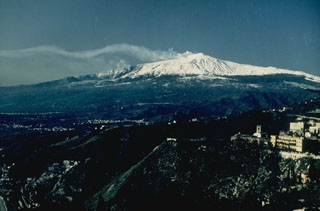Report on Etna (Italy) — 30 April-6 May 2025
Smithsonian Institution / US Geological Survey
Weekly Volcanic Activity Report, 30 April-6 May 2025
Managing Editor: Sally Sennert.
Please cite this report as:
Global Volcanism Program, 2025. Report on Etna (Italy) (Sennert, S, ed.). Weekly Volcanic Activity Report, 30 April-6 May 2025. Smithsonian Institution and US Geological Survey.
Etna
Italy
37.748°N, 14.999°E; summit elev. 3357 m
All times are local (unless otherwise noted)
The Sezione di Catania - Osservatorio Etneo (INGV) reported continuing activity at Etna during 28 April-4 May, characterized by Strombolian activity, lava fountains, and lava overflows at SE Crater and gas emissions at Bocca Nuova Crater, NE Crater, and Voragine. Activity at SE Crater began at 2357 on 29 April based on webcam views, though the views were obscured by dense weather clouds during the first hour. Visibility significantly improved at about 0200 on 30 April and by then lava was flowing over the SE Crater rim, with several branches advancing to the SE and S. Multiple vents at the summit of SE Crater produced explosive activity at variable intensities, with jets of material rising 300-400 m high. Strombolian explosions at the main vent in the W part of the crater became sustained at around 0245 producing pulsating lava fountains. Lava flows reached the base of the cone and fanned out towards Monte Frumento Supino. The activity decreased at around 0330 with lava fountaining changing to Strombolian activity that lasted for about three hours. By 0615 Strombolian activity was no longer visible and ash emissions rose 1,5 km above the summit and drifted SW. The ash emissions became discontinuous and then ceased at 0910. Satellite data from 2 May was used to map the flows. Both the SE and S flows were about 1.6 km long.
Geological Summary. Mount Etna, towering above Catania on the island of Sicily, has one of the world's longest documented records of volcanism, dating back to 1500 BCE. Historical lava flows of basaltic composition cover much of the surface of this massive volcano, whose edifice is the highest and most voluminous in Italy. The Mongibello stratovolcano, truncated by several small calderas, was constructed during the late Pleistocene and Holocene over an older shield volcano. The most prominent morphological feature of Etna is the Valle del Bove, a 5 x 10 km caldera open to the east. Two styles of eruptive activity typically occur, sometimes simultaneously. Persistent explosive eruptions, sometimes with minor lava emissions, take place from one or more summit craters. Flank vents, typically with higher effusion rates, are less frequently active and originate from fissures that open progressively downward from near the summit (usually accompanied by Strombolian eruptions at the upper end). Cinder cones are commonly constructed over the vents of lower-flank lava flows. Lava flows extend to the foot of the volcano on all sides and have reached the sea over a broad area on the SE flank.

